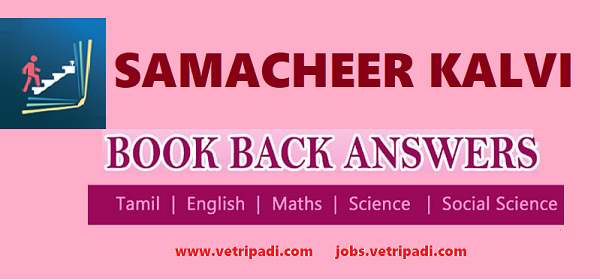8th Social Science – History Book Back
& Questions Answers (solution)
Term 3
2 Status of Women in India through the Ages
8th Social Science History Solutions Term 3 – Chapter 2 Status of Women in India through the Ages Tamilnadu Samacheer Kalvi – English Medium
I. Choose the correct answer:
1. …………… society is constantly changing with additions, assimilation and omissions from within and outside.
(a) Human
(b) Animal
(c) Forest
(d) Nature
Answer: (a) Human
2. The First woman doctor in India was
(a) Dharmambal
(b) Muthulakshmi Ammaiyar
(c) Moovalur Ramamirdham
(d) Panditha Ramabai
Answer: (b) Muthulakshmi Ammaiyar
3. The practice of sat was abolished in.
(a) 1827
(b) 1828
(c) 1829
(d) 1830
Answer: (c) 1829
4. B.M Malabar was a
(a) teacher
(b) doctor
(c) lawyer
(d) journalist
Answer: (d) journalist
5. Which of the following was/were the reform movement(s)?
(a) Brahma Samaj
(b) Prarthana Samaj
(c) Arya Samaj
(d) all the above
Answer: (d) all the above
6.The Bethune school was founded in by J.E.D. Bethune.
(a) 1848
(b) 1849
(c) 1850
(d) 1851
Answer: (b) 1849
7. Which commission recommended to start primary schools for girls in 1882?
(a) Wood’s
(b) Welly
(c) Hunter
(d) Muddiness
Answer: (c) Hunter
8. Sara’s child Marriage Bill fixing the minimum marriageable age for girls at.
(a) 11
(b) 12
(c) 13
(d) 14
Answer: (d) 14
II. Fill in the Blanks:
- ……………. society was setup by the Christian missionaries in 1819.
- ……………. of Sivaganga fought bravely against the British.
- Servants of India Society was started by ……………
- ……………. was the one of the greatest social reformer of Tamil Nadu.
- Kandukuri Veeresalingam published a journal called …………….
Answer:
- Calcutta Female Juvenile
- Velunachiyar
- Gopala Krishna Gokhale
- Periyar E.V.R
- Viveka Vardhani
III. Match the following:
- Theosophical society – Italian traveler
- Sarada Sadan – Social evil
- Wood’s Despatch – Annie Besant
- Niccolo Conti – Pandita RamaBhai
- Dowry – 1854
Answer:
- Theosophical society — Annie Besant
- Sarada Sadan — Pandita RamaBhai
- Wood’s Despatch — 1854
- Niccolo Conti — Italian traveler
- Dowry — Social evil
IV. State True or False:
- Women were honoured in Rig Vedic period.
- Devadasi system was a social evil.
- Raja Rammohan Roy, was the pioneer of Indian social reform movement.
- Reservation of 23 percent to women envisaged an improvement in the sociopolitical status of women.
- The age of marriage was raised for boys and girls by the Sharda Act of 1930.
Answer:
- True
- True
- True
- False
- True
V. Choose the correct statement:
1. Find out the correct pair:
(a) Women’s university – Prof. D.K. Karve
(b) Justice Ranade – Arya Samaj
(c) Widow Remarriage Act – 1855
(d) Rani Lakshmi Bhai – Delhi
Answer: (a) Women’s university – Prof. D.K. Karve
2. Find the odd
(a) Child marriage devadasi system)
(b) sati
(c) devadasi system
(d) widow remarriage
Answer: (d) widow remarriage
3. Consider the following Statements
i) Begum Hazarat Mahal, Rani Lakshmi Bhai led an armed revolt against the British
ii) Velunachiyar of Sivaganga, Tamil Nadu fought bravely against the British Which of the statement (s) given above is/or correct?
(a) i only
(b) ii only
(c) i and ii
(d) neither i nor ii
Answer: (c) i and ii
4. Assertion (A): Raja Rammohan Roy is most remembered by all Indians
Reason (R): He wiped out the evil practice of Sati form the Indian Society
(a) A and R are wrong
(b) A is correct and R is Wrong
(c) A is correct and R explains A
(d) A is correct and R does not explain A
Answer: (c) A is correct and R explains A
VI. Answer the following in one or two sentences:
1. Name the prominent leaders who fought for the enlistment of women.
Answer:
During the British Raj, many socioreligious reformers like Raja Rammohan Roy, Dayananda Saraswathi, Keshab Chandra Sen, Iswara Chandra Vidya Sagar, Pandita Ramabai, Dr. Muthulakshmi, Jyoti rao phule, Periyar E.V.R, Dr. Dharmambal were the prominent leaders who fought for the upliftment of women.
2. List out some social evils.
Answer:
Sati, child marriages, female infanticide, Purdah system and slavery were some of the social evils that existed in Indian Society.
3. Who were the notable women during the medieval period?
Answer:
Some of the notable women during the medieval period were Razia sultana, Queen Durgavati, Chand bibi, Nurjahan, Jahan nara, Jijabai and Mira bai.
4. Mention the important women freedom fighters of India.
Answer:
Velunachiyar of Sivaganga, Begum Hazrat Mahal and Rani Lakshmi Bhai of Jhansi were important women freedom fighters of India.
5. Give a note on Sati.
Answer:
- Sati was social evil that prevailed in Indian Society especially among the Rajputs,
- The feudal society of the time encouraged “sati” which meant self-immolation of the widow on the funeral pyre of her husband.
- Earlier it was a voluntary act but later by the relatives forced the widow to sit on the funeral pyre.
VII. Answer the following:
- Trace the role of women in freedom struggle.
Answer:
- The spread of female education led to several other social reforms of great consequences, such as the abolition of purdah system, participation of women in the freedom struggle.
- In the early anti-colonial Struggle women played major roles in various capacities,
- Velunachiyar of Sivaganga fought violently against the British and restored her rule in Sivaganga.
- Begum Hazrat Mahal, Rani Lakshmi Bhai of Jhansi led an armed revolt of 1857* against the British.
- In the freedom struggle thousands of women came out of their homes, boycotted foreign goods, marched in processions, defied laws, received lathi charges and Courted jails.
2. Explain the contribution of the Social Reformers for the eradication of social evils.
Answer:
The contribution of the social reformers for the eradication of social evils is listed below.
(a) Raja Ram Mohan Roy:
- Raja Rammohan Roy was, the pioneer of Indian social reform movement by abolishing sati in 1829 with the help of Lord William Bentinck.
- He also protested against the child marriage and female infanticide and favoured the remarriage of widows.
(b) Ishwar Chandra Vidhyasagar:
- Ishwar Chandra Vidhyasagar carried on the movement for female education, widow remarriage and abolition of polygamy in Bengal.
- He was instrumental to passing of the Hindu Widow Remarriage Act in 1856.
- His son Narayanachandra set an example to others by marrying a widow of his choice.
(c) Kandukuri Veeresalingam:
- Veeresalingam Pantulu published a journal Viveka Vardhani.
- He opened his first girls’ school in 1874, and made widow remarriage and female education the key points of his programme for social reform.
(d) M.G. Ranade and B.M. Malabari:
- In Bombay presidency, M.G. Ranade and B.M. Malabari carried on the movement
for the upliftment of women. - In 1869, Ranade joined the Widow Remarriage Association and encouraged widow remarriage and female education.
- He opposed child marriage..
- In 1884, B.M. Malabari, a journalist, started a movement for the abolition of child marriage.
(e) Gopal Krishna Gokhale:
In 1905, Gopal Krishna Gokhale started the Servants of India Society to reform the society with various measures.
(f) Periyar E.V.R:
Periyar E.V.R. was one of the greatest social reformers of Tamil Nadu. He advocated upliftment of women education, widow remarriage and opposed child marriages.
(g) Women Reformers:
- In 1889, Pandita Ramabai opened Sarada Sadan for Hindu widows in Bombay.
- Dr. Annie Besant established Theosophical society to developed general social reform programme.
- Dr. S.Dharmambal showed great interest in implementing widow remarriage and women education.
- Moovalur Ramamirdham Ammaiyar opposed Devadasi system along with Dr. Muthulakshmi Ammaiyar.
3. Give a detailed account on the Impact of reform movement.
Answer:
- Significant advances were made in the field of emancipation of women.
- It created of national awakening among the masses.
- It created the feeling of sacrifice, service and rationalism.
- The practice of sati and infanticide were made illegal.
- It permitted widow remarriage.
- The following legislations have enhanced the status of women in matters of marriage adoption and inheritance.
Legislation Provisions:
- Bengal regulation of XXI, 1804 – Female infanticide was declared illegal
- Regulation of XVII, 1829 – Practice of sat was declared illegal
- Hindus Widow’s Remarriage Act, 1856 – It permitted widow remarriage
- The Native Marriage Act, 1872 – The Child Marriage was prohibited
- The Sharda Act, 1930 – The age of marriage was raised for boys and girls
- Devadasi abolition Act, 1947 – It abolished Devadasi system
Tags:
8th social guide samacheer kalvi,samacheer kalvi 8th books guide social science,social guide for 8th standard samacheer kalvi,samacheer kalvi guru 8th social guide,8th standard social guide samacheer kalvi,samacheer kalvi 8th social guide pdf,8th social guide tamil medium samacheer kalvi,8th social guide tamil medium samacheer kalvi,samacheer kalvi 8th books guide social science,samacheer kalvi guru 8th social guide,samacheer kalvi 8th social guide pdf,8th standard social guide samacheer kalvi,8th social guide tamil medium samacheer kalvi,8th social guide tamil medium samacheer kalvi,social guide for 8th standard samacheer kalvi,samacheer kalvi 8th books guide social science,samacheer kalvi guru 8th social guide,social guide for 8th standard samacheer kalvi,samacheer kalvi 8th social guide pdf,8th standard social guide samacheer kalvi,samacheer kalvi 8th books guide social science,samacheer kalvi guru 8th social guide,social guide for 8th standard samacheer kalvi,8th social guide tamil medium samacheer kalvi,8th standard social guide samacheer kalvi,8th social guide tamil medium samacheer kalvi,samacheer kalvi 8th social guide pdf,samacheer kalvi 8th books guide social science,social guide for 8th standard samacheer kalvi,samacheer kalvi guru 8th social guide,8th social guide tamil medium samacheer kalvi,8th standard social guide samacheer kalvi,samacheer kalvi 8th social guide pdf,8th social guide tamil medium samacheer kalvi,samacheer kalvi 8th books guide social science,social guide for 8th standard samacheer kalvi,samacheer kalvi guru 8th social guide,8th social guide tamil medium samacheer kalvi,8th social guide tamil medium samacheer kalvi,samacheer kalvi 8th social guide pdf,8th standard social guide samacheer kalvi,samacheer kalvi 8th books guide social science,samacheer kalvi guru 8th social guide,social guide for 8th standard samacheer kalvi,samacheer kalvi 8th social guide pdf,8th standard social guide samacheer kalvi,8th social guide tamil medium samacheer kalvi,samacheer kalvi 8th books guide social science,social guide for 8th standard samacheer kalvi,samacheer kalvi guru 8th social guide,8th social guide tamil medium samacheer kalvi,8th standard social guide samacheer kalvi,samacheer kalvi 8th social guide pdf,8th social guide tamil medium samacheer kalvi,


